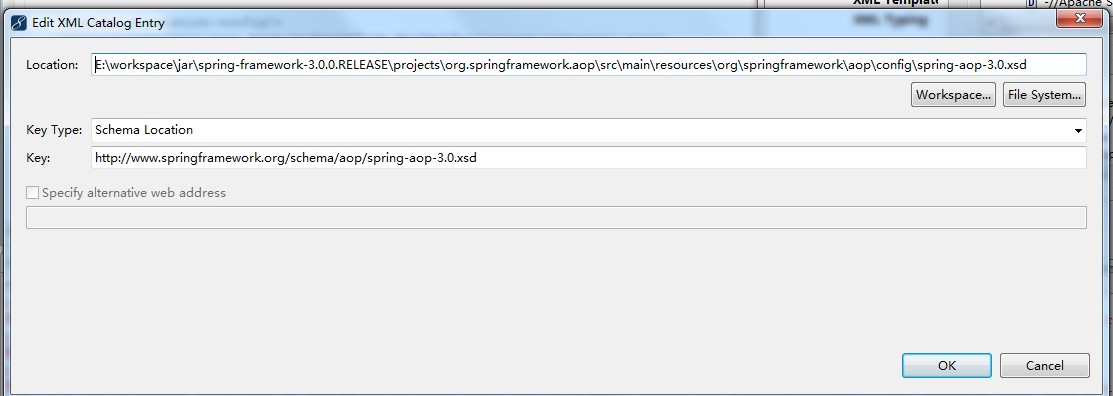Spring框架的AOP
Spring学习笔记(四)
本文目录
1 AOP的介绍
2 Spring的AspectJ实现AOP(annotation)
3 Spring的AspectJ实现AOP (XML)
Spring文档http://docs.spring.io/spring/docs/4.0.0.BUILD-SNAPSHOT/spring-framework-reference/htmlsingle/
一 AOP介绍
spect Oriented Programming(AOP),面向切面编程。AOP主要实现的目的是针对业务处理过程中的切面进行提取,它所面对的是处理过程中的某个步骤或阶段,以获得逻辑过程中各部分之间降低耦合的隔离效果
简单来说就是在方法的前后加一层过滤的方法
如果类实现了interface接口,通过使用动态代理(Proxy),通过拦截一个对象的行为并添加我们需要的功能来完成
如果没有实现接口的类,可以使用Cglib代理实现AOP
AOP用途比较广,适合切面的功能都可以使用AOP,比如打日志,声明式的事务的管理,性能测试,权限检查等
通过invocationhandle和Proxy实现
测试代码
接口DO
package proxy.service;
public interface Do {
public void doSomething();
}
DO接口的实现
package proxy.service;
public class DoImpl implements Do {
@Override
public void doSomething() {
System.out.println("doimpl...");
}
}
动态代理的实现,invocationhandle和Proxy
package proxy.service; import java.lang.reflect.InvocationHandler;
import java.lang.reflect.InvocationTargetException;
import java.lang.reflect.Method;
import java.lang.reflect.Proxy; public class dynamicProxy implements InvocationHandler {
private Object target; public dynamicProxy(Object target) {
this.target = target;
} public void before(Method method) {
System.out.println(method.getName() + "调用开始");
} public void after(Method method) {
System.out.println(method.getName() + "调用结束");
} public static Object newInstance(Object target) {
return Proxy.newProxyInstance(target.getClass().getClassLoader(),
target.getClass().getInterfaces(), new dynamicProxy(target));
} @Override
public Object invoke(Object proxy, Method method, Object[] args) {
Object result = null;
try {
before(method);
result = method.invoke(target, args);
} catch (IllegalArgumentException e) {
e.printStackTrace();
} catch (IllegalAccessException e) {
e.printStackTrace();
} catch (InvocationTargetException e) {
e.printStackTrace();
} finally {
after(method);
}
return result;
}
}
测试类
package proxy.service.test; import static org.junit.Assert.*; import org.junit.Before;
import org.junit.Test; import proxy.service.Do;
import proxy.service.DoImpl;
import proxy.service.dynamicProxy; public class dynamicProxyTest { @Before
public void setUp() throws Exception {
} @Test
public void testDynamicProxy() {
Do doSth = (Do) dynamicProxy.newInstance(new DoImpl());
doSth.doSomething();
}
}
执行结果
doSomething调用开始
doimpl...
doSomething调用结束
在不改动实现类和接口的情况下,通过invocationhandle和Proxy实现动态代理在方法的前后插入了业务逻辑
二、Spring的AspectJ实现AOP(annotation)
1 添加JAR包
aspectjrt.jar aspectjweaver.jar
2 XML的配置
xmlns:aop="http://www.springframework.org/schema/aop"
xsi:schemaLocation = "http://www.springframework.org/schema/aop
http://www.springframework.org/schema/aop/spring-aop.xsd"
<?xml version="1.0" encoding="UTF-8"?>
<beans xmlns="http://www.springframework.org/schema/beans"
xmlns:xsi="http://www.w3.org/2001/XMLSchema-instance"
xmlns:aop="http://www.springframework.org/schema/aop"
xmlns:context="http://www.springframework.org/schema/context"
xsi:schemaLocation="http://www.springframework.org/schema/beans
http://www.springframework.org/schema/beans/spring-beans.xsd
http://www.springframework.org/schema/context
http://www.springframework.org/schema/context/spring-context.xsd
http://www.springframework.org/schema/aop
http://www.springframework.org/schema/aop/spring-aop.xsd"> <context:annotation-config/>
<context:component-scan base-package="com"></context:component-scan>
<aop:aspectj-autoproxy></aop:aspectj-autoproxy> </beans>

3 新建切面类
package com.aop; import org.aspectj.lang.ProceedingJoinPoint;
import org.aspectj.lang.annotation.AfterReturning;
import org.aspectj.lang.annotation.Around;
import org.aspectj.lang.annotation.Aspect;
import org.aspectj.lang.annotation.Before;
import org.aspectj.lang.annotation.Pointcut;
import org.springframework.stereotype.Component; @Aspect
@Component
public class logInterceptor {
@Before("execution(public void com.daoImpl.UserDaoImpl.*(..))")
public void beforMethod(){
System.out.println("aspectJ before method");
}
@AfterReturning("execution(public void com.daoImpl.UserDaoImpl.*(..))")
public void afterMethod(){
System.out.println("aspectJ after method");
} }
@Aspect在类名上方注解表示实现Aspect的类
@Before表示方法运行前
@AfterReturning表示在方法执行之后
他们的语法建议记住 execution即可
execution(<修饰符模式>? <返回类型模式> <方法名模式>(<参数模式>) <异常模式>?) 除了返回类型模式、方法名模式和参数模式外,其它项都是可选的,可使用通配符
例如
execution( public void com.daoImpl.UserDaoImpl.* (com.entity.User) )//这里没有异常
(<修饰符模式>? <返回类型模式> <方法名模式> (<参数模式>) <异常模式>?)
具体详见传送门http://dylanxu.iteye.com/blog/1312454
测试类
package com.serviceImpl.test;
import org.junit.Before;
import org.junit.Test;
import org.springframework.context.support.ClassPathXmlApplicationContext; import com.entity.User;
import com.serviceImpl.UserServiceImpl; public class UserServiceImplTest {
User user; @Before
public void setUp() throws Exception {
user = new User();
user.setName("testName");
user.setRemark("testRemark");
} @Test
public void testAdd() {
ClassPathXmlApplicationContext app = new ClassPathXmlApplicationContext("beans.xml");
UserServiceImpl UserServiceImpl = (UserServiceImpl)app.getBean("userServiceImpl");
UserServiceImpl.add(user);//调用方法
UserServiceImpl.update(user);//调用方法
}
}
执行结果
aspectJ before method
testName-->testRemark save --调用UserDaoImpl!
aspectJ after method
aspectJ before method
testName-->testRemark update --调用UserDaoImpl!
aspectJ after method
通过@Aspect,@Before,@AfterReturning 成功的在方法的前后加入了切面逻辑
介绍另外几个常用的annotation
@Pointcut
@Pointcut("execution(public void com.daoImpl.UserDaoImpl.*(com.entity.User))")
Pointcut提供了一个切面的切入点切必须写在一个空方法上面
public class logInterceptor {
@Pointcut("execution(public void com.daoImpl.UserDaoImpl.*(com.entity.User))")
public void myAop(){};
@Before("myAop()")
public void beforMethod(){
System.out.println("aspectJ before method");
}
@AfterReturning("myAop()")
public void afterMethod(){
System.out.println("aspectJ after method");
}
}
@Before("myAop()") 效果等于 @Before("execution(public void com.daoImpl.UserDaoImpl.*(com.entity.User))")
执行效果与之前的执行效果一致
@Around
@Around("execution(public void com.daoImpl.UserDaoImpl.*(com.entity.User))")
Around标签,可循环执行方法 注意---> pjp.proceed();重复了三次
package com.aop; import org.aspectj.lang.ProceedingJoinPoint;
import org.aspectj.lang.annotation.AfterReturning;
import org.aspectj.lang.annotation.Around;
import org.aspectj.lang.annotation.Aspect;
import org.aspectj.lang.annotation.Before;
import org.aspectj.lang.annotation.Pointcut;
import org.springframework.stereotype.Component; @Aspect
@Component
public class logInterceptor {
@Pointcut("execution(public void com.daoImpl.UserDaoImpl.*(com.entity.User))")
public void myAop(){};
@Around("myAop()")
public void around(ProceedingJoinPoint pjp) throws Throwable{
System.out.println("aspectJ before method");
pjp.proceed();
pjp.proceed();
pjp.proceed();
System.out.println("aspectJ after method");
}
}
测试类
package com.serviceImpl.test;
import org.junit.Before;
import org.junit.Test;
import org.springframework.context.support.ClassPathXmlApplicationContext; import com.entity.User;
import com.serviceImpl.UserServiceImpl; public class UserServiceImplTest {
User user; @Before
public void setUp() throws Exception {
user = new User();
user.setName("testName");
user.setRemark("testRemark");
} @Test
public void testAdd() {
ClassPathXmlApplicationContext app = new ClassPathXmlApplicationContext("beans.xml");
UserServiceImpl UserServiceImpl = (UserServiceImpl)app.getBean("userServiceImpl");
UserServiceImpl.add(user);//调用方法
UserServiceImpl.update(user);//调用方法
}
}
执行结果
aspectJ before method
testName-->testRemark save --调用UserDaoImpl!
testName-->testRemark save --调用UserDaoImpl!
testName-->testRemark save --调用UserDaoImpl!
aspectJ after method
aspectJ before method
testName-->testRemark update --调用UserDaoImpl!
testName-->testRemark update --调用UserDaoImpl!
testName-->testRemark update --调用UserDaoImpl!
aspectJ after method
pjp.proceed();重复了三次
从结果中得到方法也确实执行了三次
通过around可以有效控制方法在这个切面里的执行次数,甚至不执行
annotation介绍到这里
通过上述资料可以掌握 @Aspect @Pointcut @Before @AfterReturning @Around 以及 execution语法
3 Spring的AspectJ实现AOP (XML)
XML配置
<?xml version="1.0" encoding="UTF-8"?>
<beans xmlns="http://www.springframework.org/schema/beans"
xmlns:xsi="http://www.w3.org/2001/XMLSchema-instance"
xmlns:aop="http://www.springframework.org/schema/aop"
xmlns:context="http://www.springframework.org/schema/context"
xsi:schemaLocation="http://www.springframework.org/schema/beans
http://www.springframework.org/schema/beans/spring-beans.xsd
http://www.springframework.org/schema/context
http://www.springframework.org/schema/context/spring-context.xsd
http://www.springframework.org/schema/aop
http://www.springframework.org/schema/aop/spring-aop.xsd"> <context:annotation-config/>
<context:component-scan base-package="com"></context:component-scan>
<aop:config>
<aop:aspect id="logInterceptor" ref="logInterceptor">
<aop:pointcut expression="execution(public void com.daoImpl.UserDaoImpl.*(..))" id="myAop" />
<aop:before pointcut-ref="myAop" method="beforMethod" /><aop:after pointcut-ref="myAop" method="afterMethod" />
</aop:aspect>
</aop:config> </beans>
由于我使用的是annotation的component组件bean配置
定义<aop:config>配置
aspect的ref表示Spring管理的bean,id应该是随意的
pointcut +表达式 + id(方法名)
before/after在与method方法之间需要+表达式或者是pointcut的id来明确切入点
切面类
package com.aop; import org.aspectj.lang.ProceedingJoinPoint;
import org.aspectj.lang.annotation.AfterReturning;
import org.aspectj.lang.annotation.Around;
import org.aspectj.lang.annotation.Aspect;
import org.aspectj.lang.annotation.Before;
import org.aspectj.lang.annotation.Pointcut;
import org.springframework.stereotype.Component; @Component
public class logInterceptor {
public void myAop(){};
public void beforMethod(){
System.out.println("aspectJ before method");
}
public void afterMethod(){
System.out.println("aspectJ after method");
}
// @Around("myAop()")
// public void around(ProceedingJoinPoint pjp) throws Throwable{
// System.out.println("aspectJ before method");
// pjp.proceed();
// System.out.println(pjp.getStaticPart());
// System.out.println("aspectJ after method");
// } }
测试类
package com.serviceImpl.test;
import org.junit.Before;
import org.junit.Test;
import org.springframework.context.support.ClassPathXmlApplicationContext; import com.entity.User;
import com.serviceImpl.UserServiceImpl; public class UserServiceImplTest {
User user; @Before
public void setUp() throws Exception {
user = new User();
user.setName("testName");
user.setRemark("testRemark");
} @Test
public void testAdd() {
ClassPathXmlApplicationContext app = new ClassPathXmlApplicationContext("beans.xml");
UserServiceImpl UserServiceImpl = (UserServiceImpl)app.getBean("userServiceImpl");
UserServiceImpl.add(user);//调用方法
UserServiceImpl.update(user);//调用方法
}
}
执行结果与annotation的一致
aspectJ before method
testName-->testRemark save --调用UserDaoImpl!
aspectJ after method
aspectJ before method
testName-->testRemark update --调用UserDaoImpl!
aspectJ after method
around的XML配置
<aop:aspect id="logInterceptor" ref="logInterceptor">
<aop:pointcut expression="execution(public void com.daoImpl.UserDaoImpl.*(..))" id="myAop" />
<aop:before pointcut-ref="myAop" method="beforMethod" /><aop:after pointcut-ref="myAop" method="afterMethod" />
<aop:around pointcut-ref="myAop" method="around"/>
</aop:aspect>
切面类
package com.aop; import org.aspectj.lang.ProceedingJoinPoint;
import org.aspectj.lang.annotation.AfterReturning;
import org.aspectj.lang.annotation.Around;
import org.aspectj.lang.annotation.Aspect;
import org.aspectj.lang.annotation.Before;
import org.aspectj.lang.annotation.Pointcut;
import org.springframework.stereotype.Component; @Component
public class logInterceptor {
public void myAop(){};
public void beforMethod(){
System.out.println("aspectJ before method");
}
public void afterMethod(){
System.out.println("aspectJ after method");
}
public void around(ProceedingJoinPoint pjp) throws Throwable{
System.out.println("aspectJ before method");
pjp.proceed();
System.out.println(pjp.getStaticPart());
System.out.println("aspectJ after method");
} }
执行结果
aspectJ before method
aspectJ before method
testName-->testRemark save --调用UserDaoImpl!
aspectJ after method
execution(void com.dao.UserDao.save(User))
aspectJ after method
aspectJ before method
aspectJ before method
testName-->testRemark update --调用UserDaoImpl!
aspectJ after method
execution(void com.dao.UserDao.update(User))
aspectJ after method
个人建议使用XML来完成AOP的切面配置,这样代码的可读性会比较强,而且配置较为灵活。
另外如果非实现接口的类需要做切面处理的话,需要引入JAR包,这里没继续研究。
通过上述资料可以掌握 @Aspect @Pointcut @Before @AfterReturning @Around注解和XML配置 以及 execution语法
最新文章
- JavaScript中的this
- zpf 路由功能
- 阿里云ECS/Ubuntu下JDK、Tomcat、MySQL安装记录
- MYSQL数据库函数集合
- MVC4发布到IIS7报404错误
- JavaScript解决命名冲突的一种方法
- SpringMVC配制全局的日期格式
- 利用EL表达式+JSTL在客户端取得数据 示例
- Spark及其应用场景初探
- CSS sprite 圆角——源代码
- JavaCodeTra 猴子选猴王 约瑟夫循环
- PowerShell_零基础自学课程_3_如何利用Powershell ISE调试PS脚本
- Memcached简明介绍
- mysql授权远程用户连接(权限最小化原则)
- 洛谷 [P1118] IOI1994 数字三角形
- POJ-2234 Matches Game---尼姆博奕裸题
- 主成分分析(PCA)原理及R语言实现 | dimension reduction降维
- 关于linux crontab定时操作oracle不执行的问题解决方案
- 加密 解密 RSA & AES & DES
- wilber3申请数据的直接目录寻找